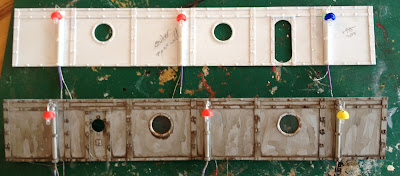 |
| The rear of Lord Smudginton Smythely-Smythe's Hydraulically Motorvated Sextupedal Land-Traversing Vacational Domicile... with many rivets. |
It's been absolutely ages since my last post, but I can assure you I have been busy! When last I spoke at you, I had completed only one of the upper walls of the engine room. There remained much to be done.
 |
| The front wall - A cavity is closed in with a panel and lantern, to shine down on the furnace. |
Well, since then, technical hitches and unseen interruptions have abounded - but I have prevailed! All four walls are now in place and I'm ready to begin construction of the dome.
 |
| Problems arise... A broken wire necessitates surgery before the port wall can be attached. |
The first technical hitch I technically hitched upon was a simple matter of my own rather amateur soldering getting the better of me. I was putting the finished port wall in place when a wire from one of the lanterns came out. "Hmmm..." I quite correctly observed, "That is a tad annoying, to say the least." There followed some wall-surgery of a slightly destructive nature and eventually I won...
But so did the swear box.
 |
| Why is that lantern not working?! The whole lantern has to be rebuilt and put back. But the result is worth it. |
The second of the aforementioned technical hitches occurred when the front wall was painted, finished and glued into place... "Why, pray tell," sayeth I, "is that there lantern thingy not all sparkly-like?" There followed some more harsh words. It was then necessary to disconnect the soldered wiring, cut off the lantern, cut it to pieces, rebuild it, put it back, and repaint the join... Fun, n'est-ce pas?
 |
| Three walls in place... |
 |
| Looking forwards from the engine. |
Anyway, with those two walls in place at last, I was able to turn my attention to the rear of the vessel. I had been unsure of how I wanted this to look, but it quickly took shape.
 |
| Ribs are cut and positioned to determine the shape of the hull. |
 |
| The rear hull is designed, detailing begins, and everything is checked for a nice fit. |
First, I needed to plan the shape of the hull by outlining the decks and attaching 'ribs' to the engine-room section. This gave me the shape of the rear hull. I determined that I wanted balconies overhanging the rear, and that the chimney-stack - protruding through the wall - should be supported with ornate Victorian-style girders.
 |
| Girders are constructed to support the chimney stack and balconies. |
 |
| A platform is attached to support the chimney stack. Rivets begin to sprout from many places... |
Portholes were added to the lowest deck. This will continue for the full length of the vessel, and every porthole will have a light behind it. This produces a few challenges of its own: If the portholes are too clear, wiring and plain board will be visible inside the vehicle. Plus, as light is actually invisible until it hits a surface, the LEDs would be doing very little unless I wanted them to be seen directly - the answer: dirty glass. I frosted the inside of the glass with watered-down white paint. This catches the light of the LEDs and looks great.
 |
| Lanterns are added by the doors and under the chimney stack. LEDs are positioned behind the portholes (under the internal deck) |
More lanterns were also added to the rear bulkhead - one over each balcony and one beneath the chimney stack. In designing these, the LED wires actually passed straight through into the wall cavity. Plastic rod and beads were glued to the wall underneath to give the appearance of being part of the lantern - but in fact are not.
 |
| RIVETS! Thousands of 'em! |
Now began the rivetting...
This was my biggest rivet-fest session yet. And just to show you all where they go, I have broken down this week's Rivet Count...
Front and Side Walls (since last post): 770
Large girders: 192
Small girders: 156
Back wall 1.6mm 'normal' rivets (exterior): 421
Platform: 58
2mm 'fat' rivets: 122
1mm 'small' rivets: 60
Back wall (interior): 332
Total added: 2,111
Bringing the total for the walker so far to: 6,670 !
That's quite a lot.
 |
| Many rivets, painted. The portholes have been dirtied, to catch the light of the now-concealed LEDs. |
With the rivets done, the painting seemed simple. And indeed it was. I think this vehicle is going to look fussy enough without adding a complicated colour-scheme, so I'm keeping things very monotone. And don't you think the red engine looks splendid against the blue-grey of the hull?
 |
| Under the engine... |
 |
| Girders await boards and handrails to complete the balconies. And the door needs a handle. |
All that remained was to wait for nightfall and turn on the lights...
 |
| All lights present and correct... |
 |
| Financier and a slovenly workman discuss... what, exactly? |
So there you go! A massive rivet-input and a good result. I hope to start on the dome soon, although things may be a little slow for a week or two, as I'm moving house...
So long, Kapiti Coast... Hello Wellington!
 |
| Lanterns lend the decks an eery glow... |
 |
| The aft-lantern and portholes. |
More soon.
All the Best!



















